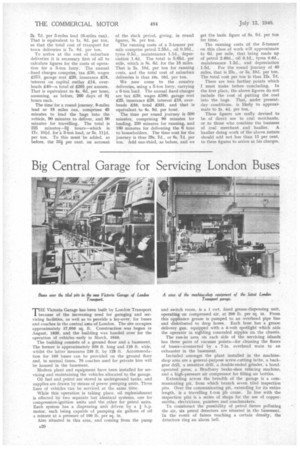Big Central Garage for Servicing London Buses
Page 22

If you've noticed an error in this article please click here to report it so we can fix it.
THE Victoria Garage has been built by London Transport because of the increasing need for garaging and servicing facilities, as well as to provide a lay-over, for buses and coaches in the central area of London. The site occupies approximately 37,000 sq. ft. Construction was begun in August, 1939, and the building was handed over for the operation of vehicles early in March, 1940.
The building consists of a ground floor and a basement. The former is approximately 350 ft. long and 128 ft. wide, whilst the latter measures 230 ft. by 128 ft. Accommodation for 100 buses can he provided on the ground floor and, in normal times, 70 coaches used for private hire will be housed in the basement, Modern plant and equipment have been installed for servicing and maintaining the vehicles allocated to the garage. Oil fuel and petrol are stored in underground tanks, and supplies are drawn by means of power pumping units. Three lines of vehicles Can be serviced at the same time.
While this operation is taking place, oil replenishment is effected by two separate but identical systems, one for compression-ignition units and the .other for petrol units. Each system has a dispensing. nnit driven by a i• h.p. motor, each being capable of pumping six gallons of oil a minute at a pressure of 100 lb. per sq. in.
Also situated in this area, and coming from the pump and switch room, is a 1 cwt. fixed grease-dispensing unit, operating on compressed air, at 200 lb. per sq. in. From this appliance grease is pumped to an overhead pipe line and distributed to drop hoses. Each hose has a grease delivery gun, equipped with a 4-volt spotlight which aids the operator in sighting concealed nipples on the chassis. The run-in area on each side of the servicing islands has three pairs of vacuum points-for cleaning the floors of buses-connected by a 7-in, overhead main to an exhauster in the basement.
Included amongst the plant installed in the machineshop area are a general-purpose screw-cutting lathe, a backgear drill, a sensitive drill, a double-ended grinder, a handoperated press, a Bradbury brake-shoe refacing machine, and a high-pressure air compressor for filling air bottles. Extending across the breadth of the garage is a communicating pit, from which branch seven tiled inspection pits. Over the communicating pit, extending for its entire length, ip a travelling 1-ton jib crane. In line with the inspection pits is a series of shops for the use of coppersmiths, electricians, painters and coachmakers. To counteract the possibility of petrol fumes polluting the air, six petrol detectors are situated in the basement. In the event of fumes reaching a certain density, the detectors ring an alarm bell.




















































